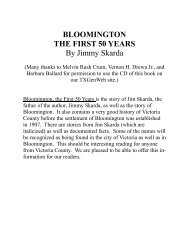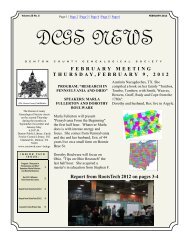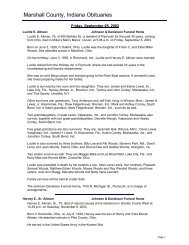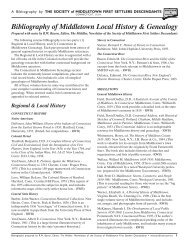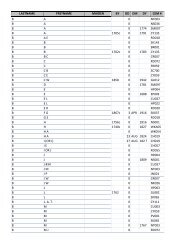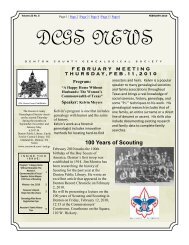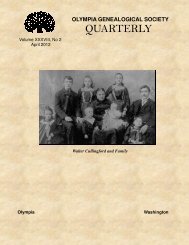Indian population in the United States and Alaska. 1910 - RootsWeb
Indian population in the United States and Alaska. 1910 - RootsWeb
Indian population in the United States and Alaska. 1910 - RootsWeb
You also want an ePaper? Increase the reach of your titles
YUMPU automatically turns print PDFs into web optimized ePapers that Google loves.
STOCKS AND TRIBES, BY SEX, AGE, AND BLOOD. 79<br />
enumeration of <strong>the</strong> census is too small seems probable.<br />
An exact enumeration, however, is, as already stated,<br />
practically impossible.<br />
Redwood (syn. Whilkut).—^A small group or tribe<br />
closely related to <strong>the</strong> Hupa. Their habitat was on<br />
Upper Redwood Creek, directly west of <strong>the</strong> Hupa <strong>in</strong><br />
Humboldt County, Cal. Located for several years<br />
previous to 1870 at Hupa Reservation, most have<br />
s<strong>in</strong>ce removed to <strong>the</strong>ir orig<strong>in</strong>al homes. The local<br />
name for <strong>the</strong>se <strong>Indian</strong>s is Redwood, a term also<br />
applied to <strong>the</strong>Huchnom, a branch of <strong>the</strong> Yukian stock<br />
<strong>in</strong> Mendoc<strong>in</strong>o County. The total number reported <strong>in</strong><br />
<strong>1910</strong> was 76, of which 74 were <strong>in</strong> California <strong>and</strong> 2 <strong>in</strong><br />
Wash<strong>in</strong>gton.<br />
Rogue River (syn. Tututni).—^A group of small<br />
tribes who <strong>in</strong> <strong>the</strong> early n<strong>in</strong>eteenth century were liv<strong>in</strong>g<br />
on <strong>the</strong> lower Rogue River <strong>and</strong> adjacent area <strong>in</strong> Curry<br />
County, Oreg. In 1856 <strong>the</strong>y were removed to Siletz<br />
Reservation <strong>and</strong> some time later were transferred to<br />
<strong>the</strong> Gr<strong>and</strong>e Ronde Reservation. The remnants are at<br />
present divided between <strong>the</strong>se two reservations. There<br />
is much confusion <strong>in</strong> <strong>the</strong> use of <strong>the</strong> term Tututni aiitl<br />
Rogue River, <strong>and</strong> among those returned as such, <strong>and</strong><br />
here tabulated, <strong>the</strong>re are probably some Chetco,<br />
Chastacosta <strong>and</strong> o<strong>the</strong>r Athapaskan tribes of this<br />
region.<br />
The number enumerated <strong>in</strong> <strong>1910</strong> was 383, of which<br />
368 were <strong>in</strong> Oregon. Strictly comparable figures for<br />
this tribe can not be obta<strong>in</strong>ed, but an approximation<br />
can be made as follows: In 1854, at <strong>the</strong> time of <strong>the</strong>ir<br />
transportation as prisoners of war to Siletz, <strong>the</strong> Rogue<br />
River were given as number<strong>in</strong>g 1,311. In 1867 <strong>the</strong>y<br />
seem still to have numbered over 1,300, but 10 years<br />
later, <strong>in</strong> 1877, were reduced to less than 700 <strong>and</strong> <strong>in</strong><br />
1881 to less than 500. S<strong>in</strong>ce that date no separate<br />
report has been made.<br />
Saiaz.—^A term of somewhat uncerta<strong>in</strong> application,<br />
applied to a portion of <strong>the</strong> Kuneste section of <strong>the</strong><br />
Pacific coast division of this stock. Their habitat<br />
s<strong>in</strong>ce earliest traditional times was <strong>in</strong> Humboldt <strong>and</strong><br />
Tr<strong>in</strong>ity Counties, Cal. They are practically one with<br />
<strong>the</strong>. Wailaki. Between 1862 <strong>and</strong> 1878 <strong>the</strong>y were<br />
ga<strong>the</strong>red first at <strong>the</strong> Smith River Reservation <strong>and</strong> also<br />
at <strong>the</strong> Hupa Reservation, but s<strong>in</strong>ce <strong>the</strong> latter date <strong>the</strong><br />
few survivors have been scattered over <strong>the</strong>ir orig<strong>in</strong>al<br />
territory. The number enumerated <strong>in</strong> <strong>1910</strong> was 6, all<br />
<strong>in</strong> California.<br />
TenanTcutch<strong>in</strong>.—One white half-breed male of this<br />
<strong>Alaska</strong>n tribe (see p. 112) was reported from Oregon<br />
<strong>in</strong> <strong>1910</strong>.<br />
TlatskanaL—K small tribe formerly liv<strong>in</strong>g on <strong>the</strong><br />
Chehalis River, Wash., <strong>and</strong> later <strong>in</strong> Columbia County,<br />
Oreg. They were supposed to be ext<strong>in</strong>ct several years<br />
ago. Three were reported from Wash<strong>in</strong>gton <strong>in</strong> <strong>1910</strong>.<br />
ToTxma (syn. Crescent City, Smith River <strong>Indian</strong>s.)—<br />
A small tribe or group belong<strong>in</strong>g to <strong>the</strong> Kuneste section<br />
of <strong>the</strong> Pacific coast division of this stock. Their<br />
habitat s<strong>in</strong>ce earhest traditional times has been <strong>in</strong> <strong>the</strong><br />
extreme northwestern corner of California, compris<strong>in</strong>g<br />
practically all of Del Norte County. Between 1862<br />
<strong>and</strong> 1868 <strong>the</strong>y were ga<strong>the</strong>red on a small reservation on<br />
Smith River which was later ab<strong>and</strong>oned, <strong>and</strong> s<strong>in</strong>ce <strong>the</strong><br />
latter date <strong>the</strong> Tolowa have not been located on a<br />
reservation. The number enumerated <strong>in</strong> <strong>1910</strong> was<br />
121, of which 118 were <strong>in</strong> California <strong>and</strong> 3 <strong>in</strong> Oregon.<br />
Vm'pqua.—^A tribal name of somewhat vague appli-<br />
cation, generally applied, however, to <strong>the</strong> <strong>Indian</strong>s of<br />
<strong>the</strong> upper Umpqua River, <strong>in</strong> Douglas County, Oreg.<br />
They were removed to <strong>the</strong> Alsea Reservation <strong>in</strong> <strong>the</strong><br />
middle of <strong>the</strong> n<strong>in</strong>eteenth century, <strong>and</strong> later divided<br />
between Siletz <strong>and</strong> Gr<strong>and</strong>e Ronde Reservation, Oreg.,<br />
*<br />
where <strong>the</strong>y still rema<strong>in</strong>.<br />
The number enumerated <strong>in</strong> <strong>1910</strong> was 109, of which<br />
90 were <strong>in</strong> Oregon <strong>and</strong> 17 <strong>in</strong> Wash<strong>in</strong>gton. Compara-<br />
tive figures from <strong>the</strong> reports of <strong>the</strong> Commissioner of<br />
<strong>Indian</strong> AflFairs are available s<strong>in</strong>ce 1860, as follows:<br />
TEAR.




